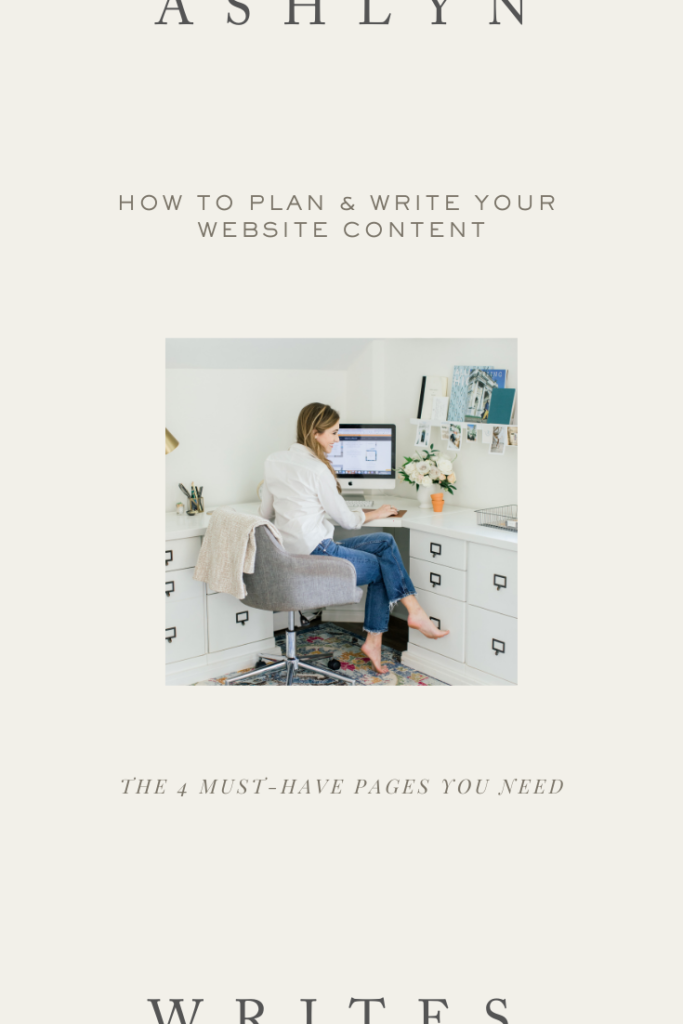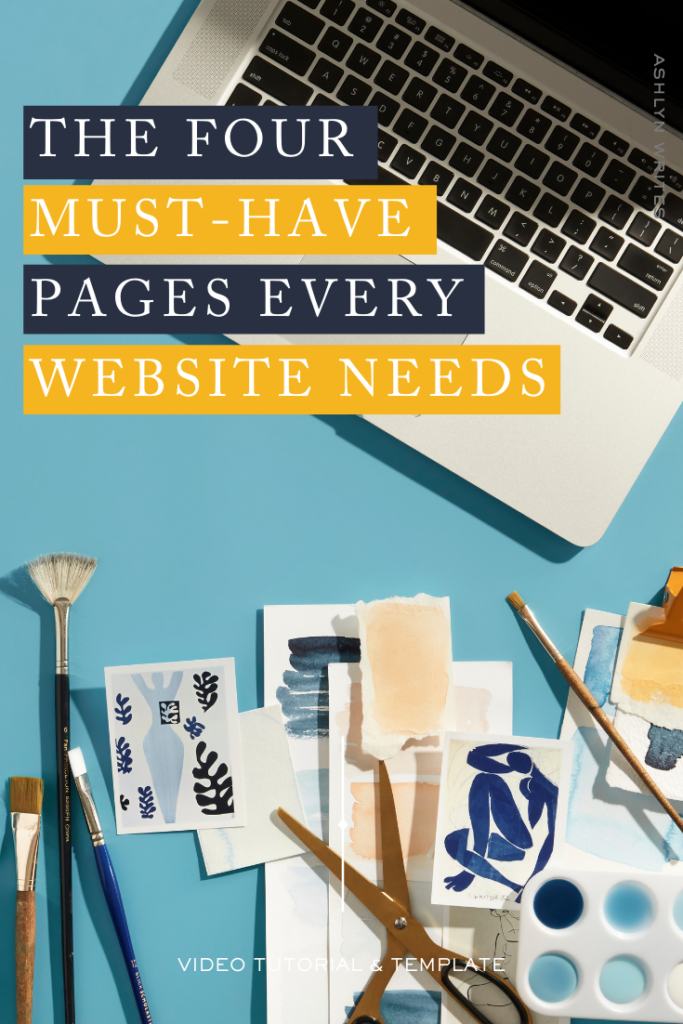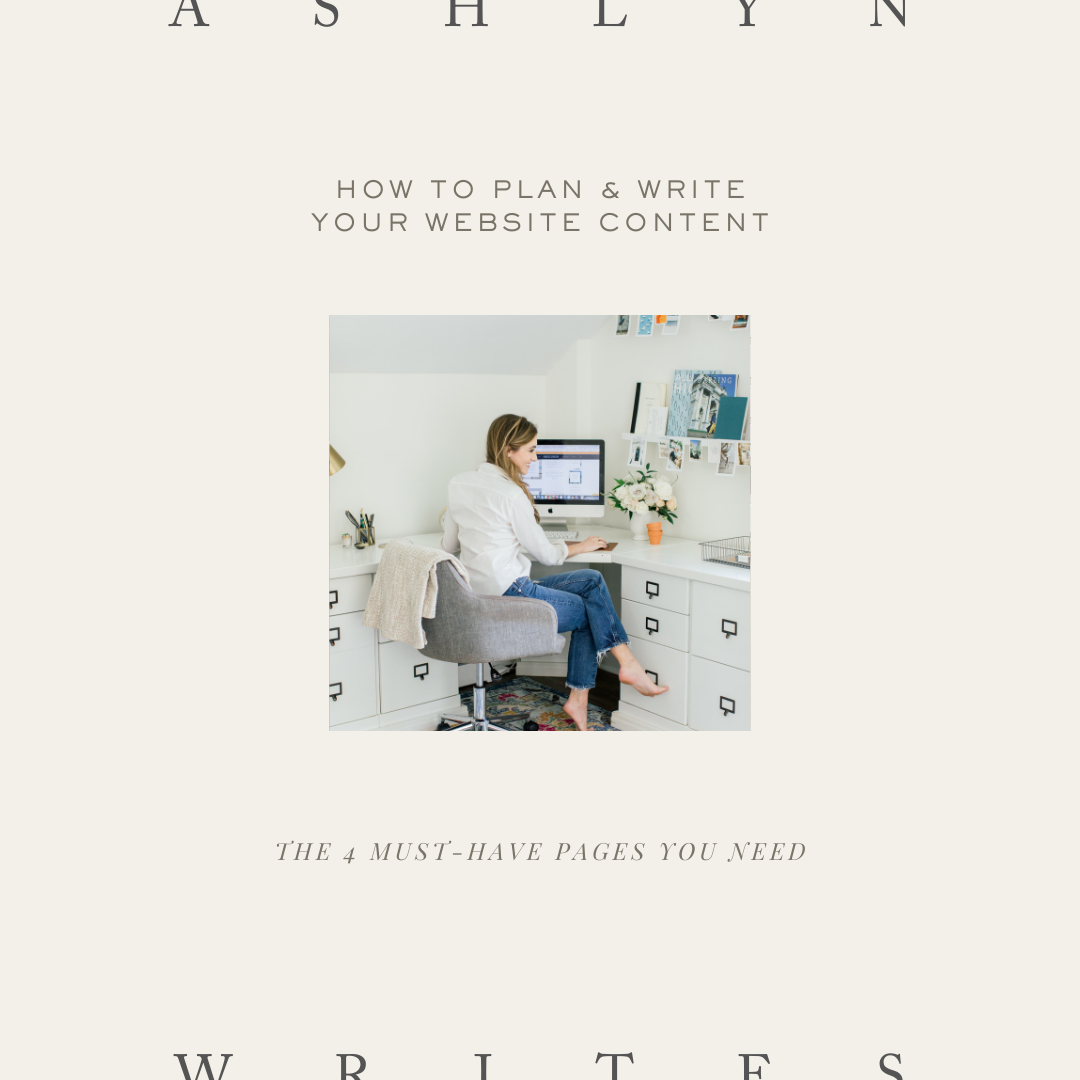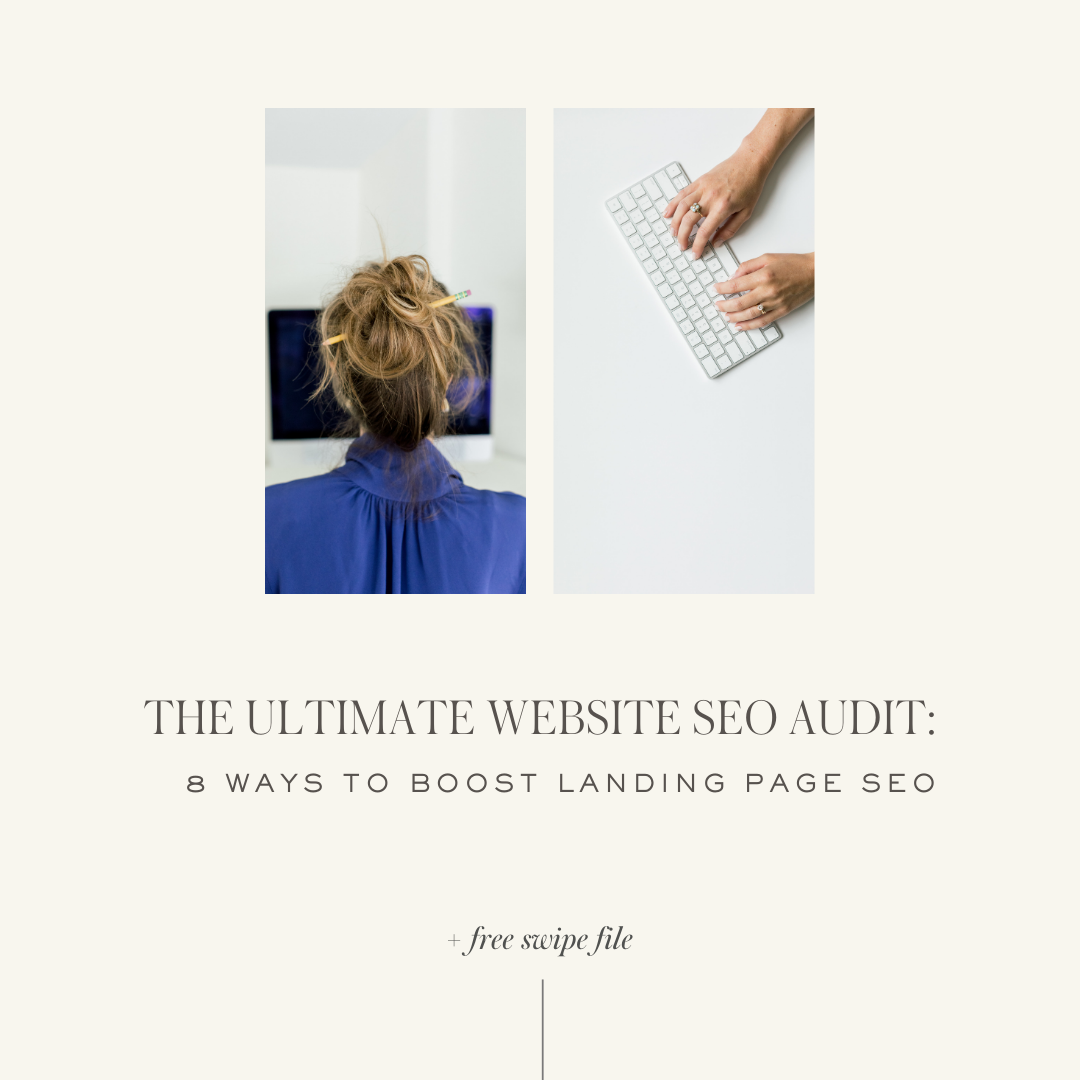Let’s talk about website copywriting.
Albert Einstein said, “If you can’t explain it to a six-year-old, “then you don’t understand it yourself,” and while he wasn’t talking about brand messaging and website copy, boy, do we tend to over-complicate things.
Today, I’m walking you through the 4 pages that you definitely have to have on your small business’s website. By the end, you’ll know a quick outline and be ramped up to wire-frame out and get ready to write the copy for those pages.
Between the agency side of my business and teaching this stuff, I look at a lot of websites—like, a whole lot. And since I primarily work with creatives and visually-prone artists, it merits being said, and I’m gonna go ahead and say it ( please don’t throw tomatoes at me!!) no, your art does not speak for itself.

Even though I know it is stunning and beautiful, we have to lean on tools like conversion copy, that I’m going to talk more about below, to make sure we pull those customers and clients over the finish line and actually help them make a buying decision and purchase.
Visuals matter greatly, and we will talk through that, but it’s that conversion website copy and then the basic sales funnel that warm people up for your price point and coach them along in the process to be willing to pay that. It helps them start to understand and process why they may need certain add-ons, or upgrades, and so many other things.
Let’s go!
⬇️Click here or down below to grab your FREE Guide for How to Define Your Brand Voice & Tone. ⬇️
No. 1 | Website Copywriting: Contact Page
We’re *actually* going to work backwards in this sales funnel, we’re starting your with your contact page.
This essentially functions as the help desk and hub for your customers or clients. I would say that a majority of the contact pages that I see from clients and students are a little bit more focused on pure function, and they lack some of that style and inspiration that’s really needed.
If you think about it, a checkout page meets a customer or a prospect at the most vulnerable point in the whole process— the moment where they have that credit card out and they’re getting ready to enter in the digits and really make this decision.
➡Your contact page functions very, very similarly.
They’re reaching out, they don’t wanna ask a dumb question, they’re hoping they have what it takes to be able to work with you or they may be frustrated and want to express something. We can’t forget the psychology of where our reader is at in the whole process.
Okay, so the meat and potatoes of this page, obviously, a form is so great, use whatever tools you use for your business here. As much as I love a tool like a HoneyBook form, I will say, I don’t think this is the best place for it.
Here’s why…
So many people create the form on their website and it assumes that I definitely want to work with you, but I may be reaching out for you for a myriad of different things—not just because I want to use your services. If your form funnels directly into your pipeline and essentially functions as an application, that may just be jumping the gun, you see what I’m saying?

Instead, I would see how you can zoom out and create a form that is either helpful for people reaching out to you for many different reasons. Or option number two, which is what I would primarily recommend, have your email address listed very clearly in case they don’t want to fill out the form. You could also have a mailing address there, and then a phone number as well.
My #1 pet peeve on contact pages is when I cannot find an email address. I remember, back when I worked in public relations, I would not pitch a brand if I couldn’t get in touch with them. Or sometimes even if the only way to get in touch with them was from a form to try to work with them, I just needed a quote for a story or something like that.
So definitely take that as a word of wisdom and put your email address on that page. It needs to be very clear and easy to find.
I would also include any types of social media and then possibly include a frequently asked questions section because this could save people an email along the way. Like I said back at the beginning of this, this page is ultimately kind of functioning as a help hub for your small business.
Last idea I have for you here is to include some sort of bar to get into your email list or your newsletter.
I know you’ve got your freebies and your pop ups and that kind of thing, but I was on New York City Ballet’s website last week, and I was just trying to sign up for their newsletter. It seems like a very simple task, but I could not find it. I was clicking everywhere, just to try, I just wanted the news, I just wanted the weekly newsletter and the scoop….soooo don’t make that harder on people than it is.
You may be interested in: 5 Ways to Know If It’s Time for a Website Refresh
No. 2 | Website Copywriting: Sales & Services Page
I know I talk about these pages all the time. When I left my corporate job, started my business, and had under one umbrella, a calligraphy side of writing and a copywriting side, on the copywriting side, I was finding myself learning how and really writing lots and lots of long-form sales letters.
At the same time, I was pedaling my services as a wedding stationer and calligrapher. Over time, I started to realize, why wasn’t I using little tricks that I knew about writing a long-form sales page and pulling them into my services page for my calligraphy work?
I started playing with it, bit by bit, found a formula that worked, and boom, the Sweet 16 Sales or Services Page template was born.
This is a list of 16 things, some of them are very short, that you absolutely need on a sales page or a services page, especially if the service is high-end or expensive.
So yes, I would say you still need these if you’re selling photography services, design services, coaching calls. Now, I don’t have time to go into all 16, but you can watch this video I did where I cover the basic format, the first five things of this, it’s called my P-A-R-I-S framework.
Essentially, you need to start this page off with the copy framework talking about either the problem or what that reader or user is pining for, what they really want.
The next thing you need to do is either agitate that problem or amplify that dream that they have, then you’ll give me a quick line where you remind them of what they really want, I want you to give me a point of interest. This can either a factoid, a stat, some sort of data point that helps solidify to the rational side of their brain why this already makes sense. We’ve worked out the emotion on that first part, now we’re gonna bring in the rational side.
And then the S is actually your solution, then we’re finally gonna get into this service or offering that you have.
Don’t forget, as you build this page and all the other pages of your website, that design is the first thing that people see. In fact, 38% of people will leave if they don’t like the design.
I said it above, I’ll say it again here, simplicity is key. That is a huge trust factor for people. They are bombarded all day with so many different marketing messages and confusing information, so when they get to your website, it needs to be so easy and clear and simple. That doesn’t necessarily correlate to short— it can be long—but it has to be simple.
No. 3 | Website Copywriting: About Page
So again, we’re backing up that funnel, and the next page is the about page.
Even if you pump out a ton of content and blog content, I would reckon that your about page falls somewhere in the top 10 most trafficked pages of your website.
Based off going backwards in this little sales funnel, we can now see that we want the goal of your about page to be to push into that sales or services page, or at least help them understand the different service options that they do have.
In a study conducted by co-marketing, they asked this question: “Once you’re on the homepage, what information would you like to see available next?”. 52% said they want the about page, or some sort of page on the company’s information.
Now, what to write here? We’ve probably heard before that your about page isn’t about you, and kind of is. At least it’s about your relationship with the reader, it tells your story, but in a way that they can see themselves in.
It connects your clients, builds your brand, and attracts and repels.
I want to share an incredible example of a website about page from Karen, one of our Copywriting for Creatives students. You will see that this page is about her, but it’s more about her ideal client. It shares bits of her story in a fun and engaging way.
Related:How to Write the Perfect About Page
No. 4 | Website Copywriting: Home Page
This is the entry page to your whole website.
Now, this page, this top of funnel page in your website is so very important because while we’re spending so much time on social media and email marketing and ads and all those fun, sexy marketing tools but if the thing at the bottom, the engine that’s got it all running, is not working as best as it can, why are we spending so much time on all of the other things?
I’ve said it many times, when writing website copy, home pages are definitely the hardest to write, at least I find that in the agency side of my business. For years, I have heard other copywriters say that and it’s simply because the myriad of different types of prospects that are leaning on this page run the gamut.
You’ve got people that are really far along in their customer journey, you’ve got people that are kind of on the fence, so ALL of those types need to feel included and spoken to on this page at some point.
Need more assistance here? I have a video where I talk through how to outline and write this page, which you can watch here.
Related:How to Write Headlines that Sell on Your Homepage
Now you know exactly the 4 pages you need as you plan your website content, but what about actually WRITING that copy you now need? Check out this video where I talk through 6 copywriting exercises you can do today. 🙂
Don’t forget to click here or down below to grab your FREE Guide for How to Define Your Brand Voice & Tone! ⬇️
LOVE THIS SLASH NEED IT BACK-POCKETED FOR LATER?
CLICK BELOW TO PIN IT!

Reading Time: 8 MinutesReading time: 8 min. Let’s talk about website copywriting. Albert Einstein said, “If you can’t explain it to a six-year-old, “then you don’t understand it yourself,” and while he wasn’t talking about brand messaging and website copy, boy, do we tend to over-complicate things. Today, I’m walking you through the 4 pages that you definitely […]




comments +